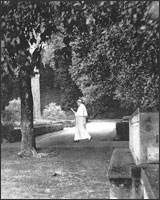THE 3 PURLE PRELATES WERE: CARDINAL SPELLMAN OF NEW YORK, CARDINAL CUSHING OF BOSTON,
AND CARDINAL MCINTYRE OF LOS ANGELES. THE SYLLABUS OF ERRORS OF POPE PIUS IX WAS DOGMA FOR THE TRIO, SO THEY RELUCTANTLY ADOPTED THE CHANGES OF VATICAN COUNCIL II. |
Another document that was very dear to the cardinals was the Bull Unum Sanctum of Pope Boniface VIII. The cardinals believed that by having a President named John, and a Pope named John, it would hasten the day when all the world would be under the Papacy!
Most thinking people believe that the assassination of President Kennedy was a conspiracy involving the Pentagon, the CIA, FBI, Mafia, Fidel Castro etc., etc. Until now, nobody has pointed a finger at the U.S. Roman Catholic hierarchy!
Imperious Pope Pius XII dominated the world from 1939 to 1958. His pet obsession was Communism and he was determined to wipe Russia off the map. To accomplish that goal he forged a close military alliance with cousins Winston Churchill and Adolf Hitler. After the defeat of Hitler, he adopted the U.S. as his new strategical partner.
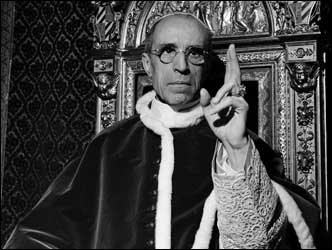 Pope Pius XII (1876–1958). Pope from 1939 to 1958. |
|
Only 6 days before his timely demise, Cardinal Spellman had a private audience with the Pope. On his voyage back to the U.S., he had to return to Roma for the funeral and the conclave.
The funeral and burial of Pope Pius XII was a very, very hasty affair because of the odor of death!
Cardinal Spellman was the first purple prelate in the Kennedy assassination!!
Cardinal Spellman was archbishop of New York, with HQ in Saint Patrick's Cathedral "The Powerhouse," in New York City.
Cardinal Francis Spellman (1889–1967). Cardinal from 1939 to 1967. |
|
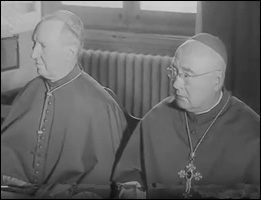 Cardinal Francis Spellman and Cardinal Albert Meyer at the Oct. 1958 conclave. |
State aid for his parochial school was actually on the ballot in New York state in November 1967. If it succeeded in New York, other states were sure to follow! It failed by a margin of 3 to 1....After that crushing defeat the cardinal's health declined rapidly and he went to "Purgatory" on December 2, 1967.
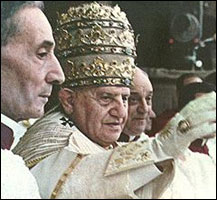 The coronation of Pope John XXIII, November 4, 1958. |
|
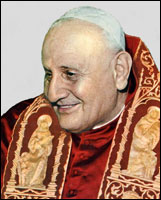 "Jovial" John XXIII. Pope from Oct. '58 to June '63. |
"Jovial" John XXIII was the very opposite of the austere, imperious Pope Pius XII. He was like a "Santa Claus" figure, dropping "presents" from his sleigh, instead of denouncing and threatening the Communists with nuclear annihilation!
Amazingly, John the Baptist—the forerunner of the Messiah—was mentioned by Josephus . . . but there is only one brief mention of the Messiah:
Now some of the Jews thought that the destruction of Herod's army came from God, and that very justly, as punishment for what he did against John, that was called the Baptist (Josephus, Antiquities, Book 18, Chapter 5).
The other famous John was John the beloved disciple, who wrote the Gospel of St. John and the Apocalypse. John was the only male disciple who remained with the Messiah when he died on the Mount of Olives!
The 15th century was a terrible time for the Papacy. At one time there were actually 3 "Holy Fathers," all calling each other "Antipope," and exercising their Christian charity by throwing thunderbolts at each other!
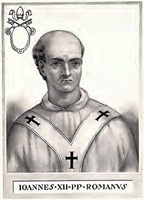 Avignon Pope John XXII (1244–1224). Reigned from 1316 to 1334. |
|
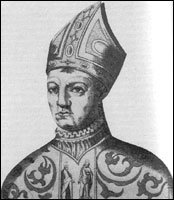 Pisan Pope John XXIII (1370–1419). Reigned from 1410 to 1415. |
Western Europe was a house divided against itself during the 15th century because of the presence of 2, and even 3 Popes, reigning simultaneously. Backing the wrong "Holy Father" could get you burned alive at the stake, as in the case of Joan of Arc.
Cardinal Spellman returned to his HQ in the "Little Vatican" in New York City a very disappointed man. However, he did appreciate the strategy behind the smiling, happy Pope John XXIII.
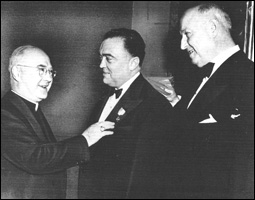 Cardinal Spellman, J. Edgar Hoover and James A. Farley. |
|
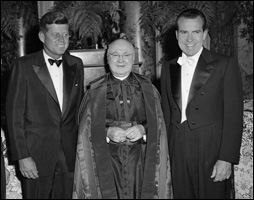 JFK, Cardinal Spellman, and Richard Nixon at the Alfred E. Smith dinner, Oct. 1960. |
After Pope John XXIII facilitated the election of JFK and launched the Ecumenical Movement, he was also given the "poisoned chalice" and sent to St. Peter.
Cardinal Spellman had to return to Roma in June 1963 for the election of Giovanni Battista Montini as Godfather.
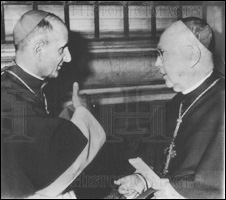 A pre-conclave conflab between Montini and Spellman. |
|
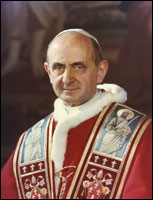 Pope Paul VI. Pope from June '63 to August '79. |
The November 1963 assassination was supposed to frame the Russians for the assassination of the President, and provide an excuse for General Curtis LeMay to launch a first strike thermonuclear attack on the Soviet Union.
Richard Cushing was the second purple prelate in the Kennedy assassination!!
Richard Cushing was named after the Babylonian Lionheart King Richard I of England. The most infamous English king named Richard was "Hunchback" Richard III, who was killed at the Battle of Bosworth Field in 1485.
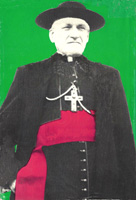 Cardinal Richard Cushing (1895 –1970). Cardinal from '58 to '70. |
|
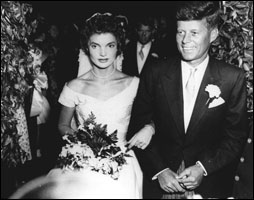 The wedding of Jack and Jackie in Newport, Rhode Island, Sept. 12, 1953. |
Archbishop Cushing was not allowed to vote in the October 1958 conclave, but the new Pope made him a cardinal in December of that same year.
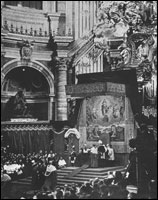 Archbishop Cushing received the purple on Dec. 18, 1958. |
|
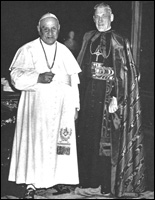 Pope John XXIII and the new Cardinal Cushing at the Vatican. |
Immediately after the assassination, Cardinal Cushing ordered Rev. John J. Cavanaugh—the Kennedys' spiritual advisor—to the White House to hear Jackie's confession.
 Rev. John J. Cavanaugh (1899–1979). |
|
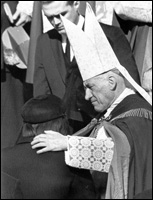 Cardinal Cushing consoling Jackie after she killed her husband. |
Cardinal Cushing knew that President Kennedy was just a lamb to the slaughter....In that case Jackie held the gun . . . and not the knife....Nevertheless, she had to confess the murder before she was allowed to attend the funeral mass for her dead husband:
There was to be a brief Mass for family and friends that morning at the White House. Father John J. Cavanaugh, a former president of Notre Dame University and a longtime Kennedy family friend, knocked on the door of Jackie's bedroom at 9:30 A.M.—just twenty hours after Jack was shot—and asked to hear her confession.
"Confession? What am I supposed to confess, Father?" she asked. Instead, she demanded to know how a caring God could "let something like this happen." (Andersen, Jackie After Jack, pp. 36-37).
The Latin rite of confession did nothing to remove the guilt of the murder of her husband. With all the consoling and confessing her sins, Jackie was still guilt-ridden and suicidal:
In June 1967, while on vacation in Ireland, Jackie attempted suicide by drowning while swimming alone in an area with a dangerous undertow. She was rescued at the last minute by her Secret Service agent John Walsh, who secretly followed her.At least one friend was convinced that the love affair with Bobby saved Jackie's life. Around the time of the anniversary, Jackie admitted to a friend that she had considered suicide. "She said that she had enough sleeping pills to do it," recalled Roswell Gilpatric, one of Jackie's closest confidants. "But of course she wouldn't because of the children. Everyone who loved her was very concerned about her state of mind. Nancy Tuckerman would call and say Jackie was in her room, too ill to keep our dinner date. All the terrible memories had flooded back, and Bobby was the only one who could pull her out of her depression." (Andersen, Jackie After Jack, p. 126).
Cardinal James Francis McIntyre was the third purple prelate in the Kennedy assassination!!
In July 1946, Monsignor McIntyre was promoted to archbishop of the archdiocese of New York. Prior to that date he practically ran the archdiocese for Cardinal Spellman.
McIntyre was a very talented financial wizard, or moneychanger. He gained such a reputation for financial acumen that Fifth Avenue was called "Comeonwealth Avenue."
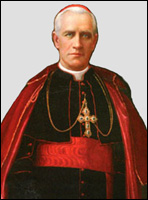 Cardinal Francis McIntyre (1886 –1979). Cardinal from 1953 to 1970. |
|
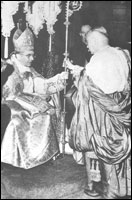 Cardinal Spellman presenting the crozier to the new archbishop of LA. |
Most to the employees of the archdiocese hated the mammon-minded prelate, and they rejoiced to see him go. They called the train that took him to LA, the "Freedom Train."
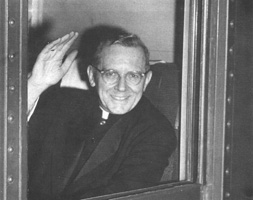 The "Freedom Train" took McIntyre to LA. |
|
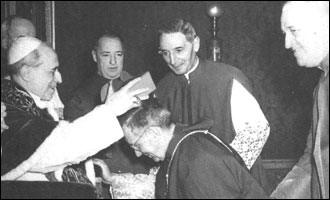 The new cardinal received the red biretta from Pope Pius XII in 1953. |
Pope Pius blessed his new cardinal and told him to continue to multiply the loaves and fishes of dollar bills!
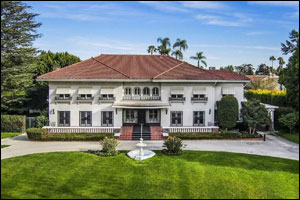 100 Fremont Place was the first residence of Cardinal McIntyre |
|
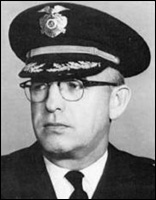 Captain William Parker (1905–1966). Chief of Police from '50 to '66. |
Under the leadership of McIntyre, the diocese of LA experienced unprecedented growth during the 50s. The handbook for the cardinal was the Syllabus of Errors of Pope Pius IX, and he tolerated no deviation from the traditional Catholic dogma.
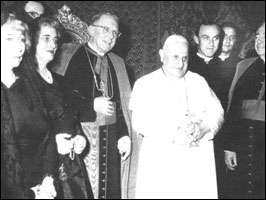 Cardinal McIntyre and the newly elected Pope John XXIII. |
|
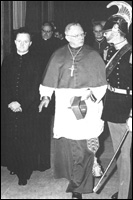 Cardinal McIntyre entering the conclave on June 19, 1963. |
Cardinal McIntyre was as shocked as all the conspirators that the coup d'etat failed, and the Soviet Union was not turned into a parking lot.
Cardinal McIntyre despised the Ecumenical Movment and the changes brought about by Vatican Council II.
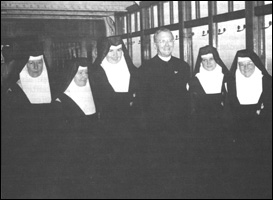 Cardinal McIntyre with his Immaculate Heart of Mary nuns. Dec. 1962. |
|
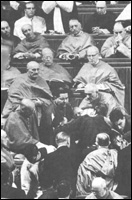 Cardinal McIntyre collapsed and almost died. Sept 14, 1964. |
The cardinal was urged to return home immediately and the council ended without him in December 1965. From that time onward he was in the ecumenical wilderness until he was forced to retire in 1970. The cardinal finally went to meet his Maker on July 16, 1979.
Vital links
References
Andersen, Christopher. Jackie After Jack. William Morrow & Co., New York, 1998.
Cooney, John. The American Pope: The Life and Times of Cardinal Spellman. Times Books, New York, 1984.
Josephus, Flavius. The New Complete Works. Translated by William Whiston. Kregel Publicastion, Grand Rapids, Michigan, 1999.
Murphy, Paul I. La Popessa. Warner Books, New York, 1983.
Watson, Thomas. The Roman Catholic Hierarchy: The Deadliest Menace to American Liberties and Christian Civilization. Jeffersonian Publishing Co., Thomson, Georgia, 1915.
Weber, Francis J. His Eminence of Los Angeles: James Francis Cardinal McIntyre. (in 2 volumes) Saint Francis Historical Society, Mission Hills, CA, 1997.
